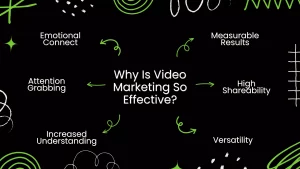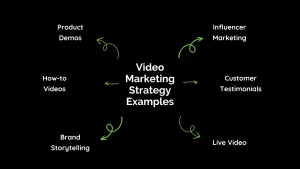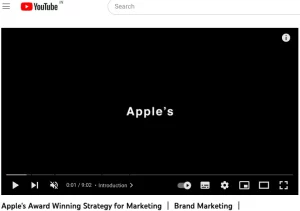What is a Video Marketing Strategy?
Video marketing started as mainstream in 2010 and was considered an expensive medium of increasing brand awareness.
The use of images and videos went viral some while back. Whether it is for consumers or for the creative brand, video marketing has become an essential element of our daily life. Today, a minute of video is equivalent to 1.8 million words. Unlike most of us, the video marketing strategy has a long history. So let’s examine the development of video marketing into the field we know it to be today.
In today’s time, 36% of the marketers believe that video marketing is important to increase brand awareness.
Read further to know what video marketing is?
What is meant by Video Marketing?
History:
- As a part of video marketing, the watch manufacturer Bulova showed the first television ad on a New York TV station during a Yankees game in 1941.
- A little over 40 years later, MTV debuted the Buggles’ song “Video Killed the Radio Star,” which foretold a message that would come true.
- Only two years later, a significant player joined the market—you guessed it—Apple, with its Super Bowl commercial for the Macintosh.
Video marketing can be referred to:
- Using video content to promote and market a product or service and increase brand awareness and engagement with an audience.
- Marketing using video that include video ads, promotional videos, explainer videos, and more.
- Video marketing aims to reach, engage and convert a target audience into customers.

Source: www.marketingstrategy.com
Some stats about video marketing (Source: Hubspot)
- Videos are believed to create high views count (44%), watch time (43%), and engagement (41%).
- The top channels for sharing videos for brand awareness or generating leads are social media (76%), blog or website (55%), and email (44%).
- 64% marketers believe that their company has highest engagement when sharing their videos on Instagram.
- Top social media for generating leads through video marketing include Instagram (66%) and YouTube (59%).
- YouTube is the most effective marketing platform to reach overall business goals.
Why Is Video Marketing So Effective?
Video engaged people that is simple but why because it keeps them informed in a simple manner either through storytelling or through data. In both the cases, the marketers are able to touch the audience’s mind easily.
About 55% of marketers say that video marketing has an average ROI and 41% marketers report video marketing has a high ROI. The data shows that use of video marketing is not losing its relevance at all. (Source: Hubspot)

Video marketing is considered adequate for several reasons:
- Emotional Connect:
Videos can evoke emotions and build a strong connection with the audience. This emotional connection can lead to higher engagement and better conversions. - Attention Grabbing:
Videos are more engaging than text or still images, making it easier to grab and hold the viewer’s attention. - Increased Understanding:
Videos can effectively convey complex information and ideas in a way that is easy to understand, leading to increased comprehension and retention. - Versatility:
Videos can be used across various platforms and channels, making them a versatile marketing tool. - High Shareability:
Videos are highly shareable on social media and other online platforms, increasing the reach and visibility of the brand. - Measurable Results:
The impact and effectiveness of video marketing can be easily tracked and measured using metrics such as views, clicks, and conversions, providing valuable insights for future campaigns.
Also Read : Why Video is future of Content Marketing?
Things To Consider When Creating A Video Marketing Strategy
When creating a video marketing strategy, some of the things to consider include the following:
-
- Target audience:
Identify the target audience and their pain points, needs and preferences to create relevant and compelling videos. - Objectives:
Clearly define the goals and objectives of the video marketing campaign, such as increased brand awareness, lead generation, or product promotion. - Value proposition:
Ensure that the videos provide value to the target audience, whether through informative, entertaining, or educational content. - Content:
Determine the specific type of content that will be produced, such as explainer videos, product demonstrations, or customer testimonials, and ensure that it aligns with the target audience and objectives. - Channels:
Select suitable channels for distributing the videos, such as social media platforms, YouTube, or the brand’s official website, and optimize them to achieve maximum reach and impact. - Measurement:
Establish relevant metrics to evaluate the success of the video marketing campaign and utilize data-driven insights to make informed decisions for future campaigns. - Budget:
Allocate sufficient funding and resources to create high-quality videos and promote them effectively. - Consistency:
Ensure that the videos are consistent with the brand’s overall marketing strategy and messaging, and maintain a consistent brand image and tone across all videos.
- Target audience:
How to Build a Video Marketing Strategy?
Thinking to increase the revenue game for your business? You can try marketing your services through video marketing strategy. These are the steps to make a fool-proof strategy:
- Define Objectives:
- Clearly define the goals and objectives of the video marketing campaign, such as increased brand awareness, lead generation, or product promotion.
- Defining objectives is crucial because it provides direction and focuses for the campaign.
- Furthermore, ensuring that the videos created are aligned with the overall goals and objectives of the marketing effort and that the campaign is designed to deliver real value to the target audience is crucial. Having clear objectives not only helps determine the success of the video marketing campaign but also provides a measurable target to work towards.
- It allows marketers to track and evaluate the performance of the videos and make data-driven decisions for future campaigns.
- Defining objectives also plays a vital role in allocating resources and budgets effectively, providing a clear understanding of what is required to achieve the desired outcomes. This, in turn, ensures that the campaign is executed with focus and efficiency, maximizing the impact and return on investment.
- Target Audience:
- Identify the target audience, their pain points, needs and preferences, and create videos catering to them.
- Understanding the target audience enables marketers to customize the content, messaging, and distribution channels to cater to their specific needs and preferences, thereby enhancing the likelihood of success.
- For instance, videos that resonate with the target audience are more likely to be viewed and shared, leading to improved engagement and conversions.
- Familiarity with the target audience also empowers marketers to comprehend the challenges and pain points their customers face, which can be effectively addressed in the videos.
- This approach fosters trust, credibility, and brand relatability among the target audience.
- Value Proposition:
- Ensure that the videos offer value to the target audience, whether informative, entertaining, or educational.
- Deciding on a value proposition for video marketing is essential because it helps ensure that the videos created offer value to the target audience. The value proposition is crucial for the video marketing campaign and content creation.
- It distinguishes the brand from competitors and makes it noticeable in a competitive market. Videos that provide real value, whether informative, entertaining, or educational, have a higher chance of being viewed and shared, thus expanding the campaign’s reach and impact.
- A transparent value proposition also establishes trust and credibility with the target audience, showing the brand’s dedication to delivering something valuable rather than solely focusing on sales. This can enhance engagement, conversions, and overall success of the video marketing campaign.
- Content:
- Determining the type of content to create is crucial for a successful video marketing campaign. The chosen content sets the tone, style, and messaging of the videos, significantly influencing their success.
- Selecting the right content ensures the videos are relevant and appealing to the target audience. For instance, if the audience is interested in product demonstrations, creating product demos would be the most effective choice. Conversely, if the audience prefers educational content, informative or tutorial videos would be more suitable.
- Content also plays a significant role in the reach and impact of the videos. Well-produced, engaging videos that provide real value are more likely to be watched and shared and lead to increased engagement and conversions.
- Channels:
- Selecting the proper channels for video distribution is crucial for successful video marketing.
- The chosen channels should be optimized for maximum impact and reach to the target audience.
- Different drains have varying strengths and are suitable for specific content or audience segments.
- Social media platforms like YouTube, Facebook, and Instagram are ideal for short, engaging videos that can be shared widely.
- Video hosting platforms like Vimeo and Wistia are better suited for longer, more professional videos like product demos or case studies.
- By understanding the target audience’s behaviour and preferences, marketers can choose the most appropriate channels for their video marketing campaigns to ensure maximum impact and reach.
- Measurement:
-
- Establishing metrics to measure the success of a video marketing campaign is crucial for understanding its impact and making informed decisions for future campaigns.
- Key metrics to track include views, engagement, conversion rates, ROI, and viewer demographics.
- Views: Number of times the video has been watched and gives an idea of its reach and popularity.
- Engagement: Level of engagement with the video, including likes, comments, shares, and subscribers.
- Conversion Rates: Number of people who have taken a desired action after watching the video, such as making a purchase, filling out a form, or subscribing to a newsletter.
- ROI (Return on Investment): Profitability of the video marketing campaign, taking into account the costs associated with producing and distributing the videos and the revenue generated from conversions.
- Viewer Demographics: Demographics of the people who have watched the videos, including age, gender, location, and interests, and helps to understand the effectiveness of the targeting efforts.
-
- Budget:
- Allocate sufficient funding and resources to create high-quality videos and promote them effectively.
- Setting a budget for a video marketing campaign is essential because it determines the resources available for creating, producing, and distributing the videos.
- The funding will also impact the scope and quality of the videos and the reach and impact of the campaign. Here are some factors to consider when setting a budget for video marketing:
- Goals: The goals of the video marketing campaign will impact the budget, as more ambitious goals will require more resources.
- Production Costs: Expenses associated with producing the videos.
- Distribution Costs: Charges for hosting and distributing the videos through various channels, such as social media platforms or video hosting sites.
- Target Audience: Find the most effective channels for distributing the videos and impact the budget for distribution costs.
- Competitor Analysis: Understanding competitors’ efforts in video marketing will provide a benchmark for setting the budget and help determine how many resources are needed to compete effectively.
- Consistency
- Ensure that the videos are consistent with the brand’s overall marketing strategy and messaging, and maintain a consistent brand image and tone across all videos.
- Remaining consistent with video marketing is essential for several reasons:
- Building Trust: Consistent video content helps to establish a brand as a trustworthy source of information and entertainment. This can help to build a loyal audience and increase the impact of future videos.
- Establishing a Presence: Consistent video content helps to establish a brand’s presence on different platforms, such as social media or video hosting sites.
- Improving Search Engine Optimization (SEO): Regular video content enhances a brand’s SEO by increasing visibility in search results and establishing a more substantial online presence.
- Engaging Audience: Regular video content engages the target audience, maintaining their interest and encouraging repeat visits. It also keeps the brand at the forefront of their minds, increasing the likelihood of desired actions such as purchases or form submissions.
- Measuring Success: Regular video content enables more precise measurement of the video marketing campaign’s success by providing a larger sample size for analysis.
- Execution:
- Create, launch, and promote the videos, and continually monitor and measure the results to make adjustments.
- Successful execution of video marketing is essential because it can help to achieve the following outcomes:
- Increased Reach and Visibility: Successful video marketing can increase the reach and visibility of a brand, making it easier to reach new and existing audiences.
- Engagement: Successful video marketing can help to engage the target audience, increasing their interest and involvement in the brand. This can build a loyal following and increase their chances of taking a desired action, such as making a purchase or filling out a form.
- Improved Conversion Rates: Successful video marketing can help to improve conversion rates by providing a more engaging and compelling way to communicate with the target audience, increasing the chances that they will take the desired action.
- Increased Sales and Revenue: By reaching a larger audience and improving conversion rates, successful video marketing can help increase brand sales and revenue.
- Brand Awareness and Reputation: Successful video marketing can help increase brand awareness and reputation by establishing a brand as a trusted source of information and entertainment and highlighting its products or services in a positive light.
- Refinement:
- Continuously refine and improve the video marketing strategy based on the results and feedback, and adjust the approach as needed to achieve the desired outcomes.
- Refining video for marketing is essential because it helps ensure that the video content effectively achieves the desired outcomes.
- In addition, refining can help improve the videos’ quality, increase their relevance and appeal to the target audience, and optimize their performance on various channels and platforms.
- Some of the critical benefits of refining video for marketing include the following:
- Increased Relevance: Refining video content can have multiple benefits. Firstly, it can increase its relevance to the target audience, making it more engaging and compelling. This, in turn, can improve the chances of the target audience taking a desired action, such as making a purchase or filling out a form.
- Improved Quality:Secondly, refining video content can improve quality, making it more professional and appealing to the target audience. This can increase the chances of the videos being shared and viewed by a larger audience.
- Optimise Performance: Refining video content can optimize performance on different channels and platforms, such as social media or video hosting sites, ensuring that the content reaches its intended audience effectively.This can increase the reach and impact of the videos and improve the chances of achieving desired outcomes.
- Increased Engagement: Refining video content can increase engagement with the target audience by making it more relevant and appealing. This can build a loyal following and increase the chances of the target audience taking a desired action.
Examples for the Strategy
Some of the impressive video marketing strategy examples include:

Here are some examples of video marketing strategies that businesses can use to achieve their marketing goals:
- Product Demos:
 Source: www.youtube.comApple is a prime illustration of a brand utilizing product demo videos to exhibit its products. Apple regularly publishes videos showcasing the features and capabilities of its newest products, including the iPhone, iPad, and Mac.These videos serve to generate enthusiasm and anticipation for the products while also offering prospective customers a more comprehensive comprehension of their functionality and potential. By presenting the products in a clear and captivating manner, Apple effectively heightens interest and demand, ultimately leading to increased sales.
Source: www.youtube.comApple is a prime illustration of a brand utilizing product demo videos to exhibit its products. Apple regularly publishes videos showcasing the features and capabilities of its newest products, including the iPhone, iPad, and Mac.These videos serve to generate enthusiasm and anticipation for the products while also offering prospective customers a more comprehensive comprehension of their functionality and potential. By presenting the products in a clear and captivating manner, Apple effectively heightens interest and demand, ultimately leading to increased sales. - How-to Videos:
 Source: www.youtube.com
Source: www.youtube.com
IKEA is a brand that effectively utilizes instructional videos to educate its customers. By producing a range of “how-to” videos, IKEA demonstrates to customers the proper assembly and usage of their furniture products. These videos alleviate the anxiety and annoyance associated with community, simplifying the process and making it more accessible for customers. - Brand Storytelling:
 Source: www.youtube.com
Source: www.youtube.com
Creating brand storytelling videos that share a brand’s history, values, and mission can help build a solid emotional connection with the target audience and improve brand awareness and reputation.A brand that effectively uses storytelling videos to connect with its audience is Coca-Cola. Coca-Cola is well-known for its emotional and heartwarming commercials that tell stories and showcase the values and emotions important to the brand.For example, Coca-Cola’s “Share a Coke” campaign featured commercials that told the stories of friends and families sharing Coca-Cola together and showcased the brand’s role in bringing people together. By using storytelling to connect with its audience emotionally, Coca-Cola can build a strong relationship with its customers and improve brand awareness and loyalty. - Influencer Marketing:

Partnering with influencers to create and promote videos that showcase a product or service can reach a more extensive, engaged audience and improve the chances of the target audience taking a desired action.A brand that effectively uses influencer video marketing is Nike. Nike frequently partners with influencers and athletes to create and promote videos showcasing their products.These videos feature influencers and athletes using Nike products in various sports and activities and help demonstrate the products’ performance and quality. By partnering with influencers, Nike can reach a larger and more engaged audience and increase interest and desire for their products.Additionally, by showcasing its products in action, Nike can build credibility and trust with its audience and improve brand awareness and reputation. - Customer Testimonials:
Amazon is a brand that effectively utilizes customer testimonial videos. These videos, frequently displayed on Amazon’s website and social media platforms, highlight genuine customers discussing their experiences with Amazon’s products and services. By incorporating customer testimonials, Amazon establishes credibility and trust with its audience by providing honest and unfiltered feedback. This approach allows Amazon to demonstrate the quality and value of its offerings, ultimately enhancing brand awareness and reputation. Moreover, customer testimonial videos foster customer trust and confidence, resulting in heightened sales and customer loyalty. - Live Video:
Procter & Gamble (P&G), a brand that effectively utilizes live video marketing, engages with its audience in real-time. P&G, responsible for renowned brands like Tide, Crest, and Pampers, frequently employs live video marketing to launch new products, address customer inquiries, and conduct live Q&A sessions. Through live video, P&G establishes a more intimate and captivating connection with its audience, offering immediate insights and information about its products.
Final Words
In conclusion, video marketing is an effective way for brands to connect with their audience and drive engagement, sales, and loyalty. Whether through product demos, “how-to” videos, storytelling, influencer marketing, customer testimonials, or live videos, the key to successful video marketing is to understand your target audience, have a clear objective, and create high-quality, engaging content. To measure success, it’s important to track key metrics such as views, engagement, conversions, and return on investment. And to ensure long-term success, it’s essential to remain consistent with your video marketing efforts and continually refine and improve your strategy based on feedback and results. With the right strategy in place, video marketing can be a powerful tool for brands to connect with their audience and drive business results.
For more details contact hello@noboruworld.com



